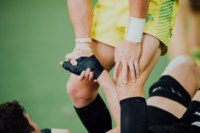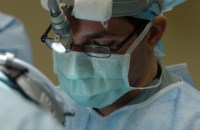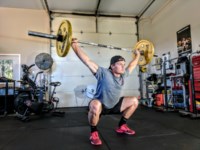 I have been teaching sports injuries assessment and treatment to doctors for over a decade. Relative to complex injuries of the shoulder or hip, knee injuries are somewhat simple to assess. Every knee malady has one or more characteristic signs that lead us to suspect the injured tissue, and thus it isn’t that difficult to advise clients on an effective path to recovery. A relatively common knee injury is a torn meniscus. This injury is characterized by pain and popping or clicking of the knee. The treatment depends both on severity and who you consult with. Most doctors use experience along with education to determine the course of action that will give you the best results. I have treated scores of meniscal injuries, and I have also recommended many cases to be evaluated by a surgeon, which a portion ultimately led to surgery. Of all the meniscal injuries I have consulted on or treated, not one was unsuccessful. So the important question for this article is: If I have knee pain and clicking – will I need surgery or can it be avoided?
I have been teaching sports injuries assessment and treatment to doctors for over a decade. Relative to complex injuries of the shoulder or hip, knee injuries are somewhat simple to assess. Every knee malady has one or more characteristic signs that lead us to suspect the injured tissue, and thus it isn’t that difficult to advise clients on an effective path to recovery. A relatively common knee injury is a torn meniscus. This injury is characterized by pain and popping or clicking of the knee. The treatment depends both on severity and who you consult with. Most doctors use experience along with education to determine the course of action that will give you the best results. I have treated scores of meniscal injuries, and I have also recommended many cases to be evaluated by a surgeon, which a portion ultimately led to surgery. Of all the meniscal injuries I have consulted on or treated, not one was unsuccessful. So the important question for this article is: If I have knee pain and clicking – will I need surgery or can it be avoided?
The menisci of the knee (there are two per knee) are shock absorbers – they provide the structural integrity of the knee joint, particularly during twisting motions. It’s no surprise then that sporting activities – basketball, dancing, even rough housing with the dog – are common causative factors for torn menisci. But don’t be mistaken: a meniscus can wear down over time without having a frank injury as the cause. In other words, how you maintain the integrity of your knees along with time and normal day-to-day movements can lead to an injury.
When a meniscus is injured it can lead to pain and swelling. An acute injury – like one from playing sports – will get inflamed, so icing immediately is a crucial first step. Because the menisci sit in the knee joint itself, between the femur (thigh bone) and tibia (shin bone), you will have to ice in the back of the knee, not the front as the knee cap obstructs the injured tissue. meniscal pain is usually felt in the back of the knee or deep inside the knee joint. This is not enough, however, to determine if a meniscal injury is present. Clinically, doctors perform the McMurray test, which puts the knee into flexion (bent) and then circumducts it (essentially a rotational move). A clicking of the knee is a positive test, and it signifies a potentially torn meniscus. Why potentially? The only definitive marker is to see the tissue on MRI – this tells us for sure whether there has been a tear or not. Why does this matter? It matters because the presence of a tear will determine the course of action with regard to treatment.
 So let us consider each option: the first would be surgery. If a tear is present on any meniscus, one recommendation might be surgery. I work closely with several orthopedic surgeons in Beverly Hills, Los Angeles and West Hollywood. These doctors on my wellness team are highly ethical and well-experienced. They are not quick to jump on the surgery wagon – simply because surgery is invasive and there is no going back. As a result, they are just as likely to recommend rehabilitation for less severe cases as they are to recommend surgery for more severe ones. In other words, a good orthopedic surgeon will guide you properly based on the severity of your injury. When surgery is needed there are two kinds. The first is the most extreme and it is a complete meniscal removal – a complete meniscectomy. This surgery is necessary depending on the size and location of the tear. Here is a great site explaining ins-and-outs of the complete meniscal surgery.
So let us consider each option: the first would be surgery. If a tear is present on any meniscus, one recommendation might be surgery. I work closely with several orthopedic surgeons in Beverly Hills, Los Angeles and West Hollywood. These doctors on my wellness team are highly ethical and well-experienced. They are not quick to jump on the surgery wagon – simply because surgery is invasive and there is no going back. As a result, they are just as likely to recommend rehabilitation for less severe cases as they are to recommend surgery for more severe ones. In other words, a good orthopedic surgeon will guide you properly based on the severity of your injury. When surgery is needed there are two kinds. The first is the most extreme and it is a complete meniscal removal – a complete meniscectomy. This surgery is necessary depending on the size and location of the tear. Here is a great site explaining ins-and-outs of the complete meniscal surgery.
The next plausible treatment is a partial meniscectomy. This is generally called arthroscopic surgery because the surgeon can shave the meniscus without cutting the knee open completely. It is a closed surgery where the tools are inserted via a puncture in the surrounding tissue and done as an outpatient procedure (you go home in a few hours). These surgeries are quick, effective, and generally easy to heal from. These surgeries are recommended when the pain and disability is too much for the patient to handle, and/or conservative treatment did not reduce either. Like I said, my clients who have had this surgery recovered quickly and have regained full function. Again, whether this be the case for you will be determined by a number of factors. Only a professional or team can guide you in this regard.
Finally, there is conservative care: nothing invasive, simply rehabilitation and palliative therapy to reduce pain, swelling, and dysfunction of the knee. People with meniscal pain can have trouble in either complete flexion of the knee (deep knee bends) or complete extension (straightening the knee) or both. Either can elicit a pop or click, although sounds tend to be more common on extension, while pain tends to be more common on flexion and twisting. People with meniscal injuries often have pain climbing stairs and/or walking/running down hill. I have had patients that could live with both these pain elicitors, that is, they elected to avoid the surgery and simply take elevators and avoid walking hills. I am not suggesting this be your decision, just that it is possible to simply modify one’s life style. However, for athletes and mobile, active people, this approach is simply not viable. For them, it is better to try and create an environment for the knee to not just alleviate pain, but to prevent further damage.
That brings me to my treatment rationale. A rationale is what we are trying to accomplish and how. Obviously we are trying to return function and remove pain; however, that would be true of all three options I have discussed thus far. So what is different in my approach? The first is that it is conservative – no invasion into the body, no cutting, no puncturing. It is a purely environmentally conscious approach. That simply means we strive to create an environment which allows the meniscus space, unrestricted blood flow, and freedom of movement. What is this last point? Freedom of movement refers to the characteristic knee locking which can happen with a torn meniscus. So the rationale of my treatment is to provide ample space for movement to occur without knee locking taking place. Obviously, knee locking is painful and restricts movement further. Also it can lead to greater damage of the meniscus.
 A final note on these meniscal injuries: NOT getting surgery immediately (for less severe cases) should not worsen the situation irreparably. However, as the years add, the greater the likelihood that damage will increase, making the pain and disability worse. Saying that, surgery is always an option on the table; just remember that the type of surgery necessary depends on the degree and location of tear. In other words, the longer you avoid surgery, the greater the probability of needing the complete meniscectomy later. Wait, wait, wait…that is a lot of information. I agree – it is maybe more than what you are looking for at this point. So my advice to you if you have knee pain, swelling, clicking, popping, or the inability to fully extend your knee or do deep knee bends without pain, see a doctor. A sports chiropractor or orthopedist is best to diagnose your knee pain and clicking condition. If you are in the Los Angeles, Beverly Hills or West Hollywood areas, please contact me for a consultation. You can have a fully functional pain-free knee, no matter how bad the pain is now – a solution exists. It simply takes the first step, which is a consult, then you should be back on the playing fields in no time.
A final note on these meniscal injuries: NOT getting surgery immediately (for less severe cases) should not worsen the situation irreparably. However, as the years add, the greater the likelihood that damage will increase, making the pain and disability worse. Saying that, surgery is always an option on the table; just remember that the type of surgery necessary depends on the degree and location of tear. In other words, the longer you avoid surgery, the greater the probability of needing the complete meniscectomy later. Wait, wait, wait…that is a lot of information. I agree – it is maybe more than what you are looking for at this point. So my advice to you if you have knee pain, swelling, clicking, popping, or the inability to fully extend your knee or do deep knee bends without pain, see a doctor. A sports chiropractor or orthopedist is best to diagnose your knee pain and clicking condition. If you are in the Los Angeles, Beverly Hills or West Hollywood areas, please contact me for a consultation. You can have a fully functional pain-free knee, no matter how bad the pain is now – a solution exists. It simply takes the first step, which is a consult, then you should be back on the playing fields in no time.

